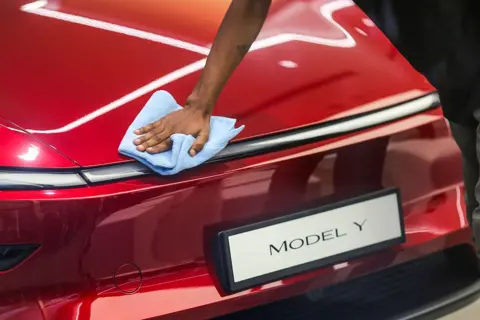**Tesla’s Ambitious Move to Reintroduce Affordability Amid Business Struggles**
Recently, Tesla has announced a plan to build more affordable cars as part of its strategy to address mounting challenges within the company. CEO Elon Musk’s electric vehicle manufacturer has faced significant obstacles, including declining car deliveries, diminishing profits, and increasing competition, particularly from Chinese car manufacturers. As Tesla makes these bold promises, it has become essential to analyze the company’s current predicament and future outlook.
On July 15, 2025, Tesla revealed that it began the initial production of a cheaper car model in June. This move comes as the firm grapples with troubling financial reports, revealing a staggering 14% drop in car deliveries over the past year, accompanied by a 16% decrease in profits. Such figures signal serious concern for a company once regarded as the frontrunner in the electric vehicle (EV) sector. The ongoing cuts to governmental support programs for electric vehicles in the U.S., fierce competition from emerging carmakers, particularly from China, and Musk’s controversial public persona have all contributed to the growing pressure on Tesla’s business model.
Tesla’s Chief Financial Officer, Vaibhav Taneja, attributed part of the company’s struggles to the cessation of a tax credit for electric car buyers in the U.S., which is expected to further harm sales. The financial ramifications are compounded by U.S. tariff policies that cost the company around $300 million last quarter, with forecasts suggesting more financial strain could develop in the near future.
Despite the unfavorable situation, Musk maintains a forward-looking perspective. He envisions that the approval of Tesla’s self-driving software in Europe will catalyze growth in sales. Musk mentioned that he anticipates obtaining initial approvals from the Netherlands, with hopes of achieving broader acceptance within the European Union, which has systematic bureaucracy. “Autonomy is where the value [of the company] skyrockets,” Musk asserted during a recent investor meeting showcasing his commitment to capitalizing on this technology.
However, even as Tesla attempts to find solutions, the type of profit margins it once enjoyed has significantly plummeted over the last several quarters. The company has reported reduced profits in five of the previous six quarters, and its stock has dropped approximately 30% since its peak last year. Musk’s increasing entanglements with politics, particularly his support for former President Donald Trump, have only muddied the waters further, worrying investors.
When concerns about Tesla’s leadership emerged, members of the board had to publicly dispel rumors regarding Musk’s potential replacement. Following Musk’s announcement of leaving the Trump administration, investors hoped he would focus solely on Tesla and distance himself from the political spotlight. However, the continued uncertainty surrounding his commitments—especially his flirtation with establishing a new political party—has kept investors on edge.
Prominent stakeholders like James Fishback, a Tesla investor and Trump supporter, have urged the board to evaluate whether Musk’s political ambitions align with his responsibilities as CEO. Analyst Dan Ives has voiced similar sentiments and even prompted Musk to respond with a terse message on social media, reinforcing the idea that the executives’ political activities could detract from their role as corporate leaders.
The company’s ongoing struggles are compounded by the reality that Tesla’s once-untouchable position in the EV market is increasingly being challenged. Daniel Binns, CEO of brand consultancy Elmwood, emphasized that the company can no longer rely solely on brand loyalty, pointing to competition as a significant hurdle. “They need more than just another car; the market has caught up to them,” he remarked, underlining the necessity for further innovation and strategic pivots beyond merely launching new models.
In conclusion, Tesla’s commitment to rolling out cheaper models is an acknowledgement of its necessity to adapt and innovate in an increasingly competitive landscape. However, the underlying business challenges, impacted by political affiliations, delivery setbacks, and dwindling profits, demonstrate that merely introducing new models may not suffice. Tesla must carefully navigate its next steps to sustain its leadership in the evolving world of electric vehicles.












